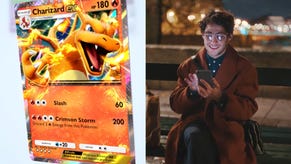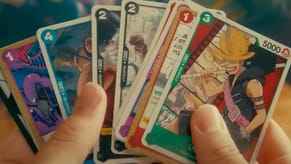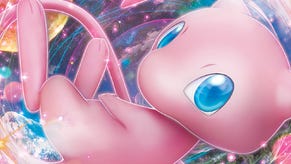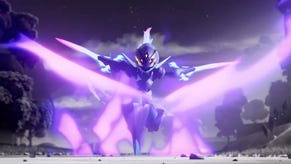Pokémon's most stunning cards are pricing people out of the TCG
Food shopping this month, or a nice drawing of Umbreon? Hm…
I love fancy Pokémon cards. The general art quality of the trading card game is higher than it has ever been. These fancy cards, such as the adorable, enormous Espeon VMax taking a nap on a whole building or Charizard and Vensaur duking it out in one of the modern game’s most valuable cards, these are the reason I can’t go to Asda without considering a flutter on a few booster packs - but therein lies the problem.
While rarity is a normal thing in all trading card games, the hierarchy of Pokémon card rarity has shifted to a point where the term “rare” means nothing. Step aside, boring cards that would previously have caused you to brag to all your mates for months. In the modern collecting game, it’s all about Rainbow Rares (a rainbow recolouring of some Pokémon and trainers), Gold Rares (a select number of blindingly sparkly bits of cardboard) and the big daddy: alternate art.
Alternate art cards are, as you’ve probably guessed, special versions of certain cards in a set that feature incredible artwork. That, were it not for the attacks and energy costs, you’d think were a bespoke piece of high-quality fan art rather than a legal card. They look so unlike anything Pokémon has ever done with its TCG, and I genuinely believe they’re a massive step in the right direction when it comes to rejuvenating the somewhat stale basic card design. However, there’s an issue.
These cards are incredibly rare. “But Pokémon has always had rare cards!” you scream, absolutely unprepared for how out of hand it has gotten over the past few sets. Let’s talk numbers. The Pokémon Company never publishes official pull rate figures, because if it did then some of the hopelessly cardboard-enamoured masses would move on. That hasn’t stopped some assiduous, and disastrously financially-irresponsible fans from working it out.
Over at TCGplayer, they took data from over 8,000 packs of Astral Radiance in order to determine just how difficult it is to pull some of the recent set’s hottest cards. From their findings, the alternate art forms of Dialga and Palkia were found in 1/864 and 1/665 packs respectively. Oh, the equivalent of 24 booster boxes isn’t shocking enough? Well, how about the fact they found alternate art Hisuian Sneasler V once in 2,160 packs? (If you’ve just pulled out your calculator, a single pack is £3.99 and a booster box is typically £124.99.)
The barrier to completing a modern set of Pokémon is two hundred feet tall and made of cash.
Sixty booster boxes. It could take you 60 booster boxes to find that chase card. That’s over seven grand, by the way. And yes, I hear your shouts of “Buy it on eBay!”, but it’s not about that specific card. It’s illustrating the absolutely ludicrous pull rates that have made the Pokémon TCG absolutely reliant on after-market purchases in order to complete sets.
I can accept a set with one or two cards that are so rare you remember exactly where you were when you pulled them, sitting shaking in your car after picking up a random pack or right at the end of a terrible booster box you bought at the spur of the moment. Those pulls are what we all live for as TCG fans. However, the sheer number of these obscenely rare cards that are being introduced every set means that on the odd occasion I do hit something special, I don’t think, “Oh wow, maybe I’ll finish the set!” I think, “Oh well, this is nice, but I might as well flog it.” The barrier to completing a modern set of Pokémon is two hundred feet tall and made of cash.

Collecting trading cards has never been a particularly fiscally responsible hobby but, in the current climate where money for entertainment - especially entertainment like trading cards, where you can literally buy a pack and get nothing you wanted - is going to be so limited, Pokémon is making it harder than ever to catch 'em all. Am I going to spend the equivalent of my next leccy bill on a booster box without any kind of guarantee that I’ll walk away with something I want?
Not having guaranteed pull rates is great for The Pokémon Company's bottom line but tough for players.
I’ve long argued for guaranteed pull rates for Pokémon. Interestingly enough, there is a guaranteed pull rate system for certain Pokémon TCG products in Japan, but it’s high time that the English-language game catches up. I know for a fact that I and many other collectors would be more invested if we knew we were guaranteed one of the 12 alternate art cards in each sealed booster. It’s a reward for the people that are so invested in your game they’re buying boxes for hundreds of pounds. This wouldn’t remotely affect the bread-and-butter customer that picks up a random pack in the shop.
Other trading card games are willing to do this for the customers that they know spend thousands. Magic: The Gathering maker (and former helmer of the Pokémon TCG) Wizards of the Coast includes guaranteed mythic MTG cards - the game’s equivalent of Ultra Rares - in at least two packs per booster box. However, The Pokémon Company seems utterly reluctant to do the same thing. Whether it’s to maintain the mystique, or the fact that these chase cards sell tons of packs, it’s great for its bottom line but tough for players.
There may be light at the end of the tunnel. With the Sword and Shield era of the Pokémon TCG coming to a close, and the final two mainline sets announced, it’s clear that The Pokémon Company is going hard on the extravagant cards. However, the first set of Sword and Shield, while featuring a few secrets, was so manageable that I basically finished it in two boxes. That’s still a lot of money, mind you, but it’s not over 2,000 packs.
The first set of the Pokémon Scarlet and Violet era launches next year and I for one can’t wait. Sure, the hits won’t be so good that your hands shake with excitement as you try to put the card in a top-loader, but you might actually fill those binders without having to sell your car.









